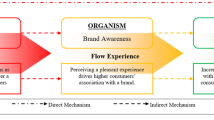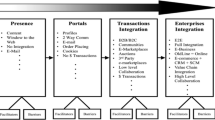Abstract
The emergence of the Internet and the World Wide Web has been argued to fundamentally reshape economic conditions and business practices of firms. It is seen as a promoter of rapid internationalisation of companies, particularly small and medium enterprises. In the aftermath of the burst of the electronic-bubble business practitioners and academics look with scrutiny on successful web-strategies, relevant dimensions of online-success and try to identify viable website practices which enable long-term rewards. The literature offers a rather patchy pattern for successful web-strategies and consumer perspectives on what is expected from websites is hardly available. Within this paper, we introduce the dimension “web-empowerment”. This is a multidimensional construct comprising of consumer views on various dimensions of relevant and successful websites. The web-empowerment scale is based on a large sample from Austria, and developed according to scale development procedures. The relevance of this construct and practical issues in the context of a cross-country sample of SME’s is empirically examined. The paper concludes by offering implications for SME practitioners and for research.
Similar content being viewed by others
References
Adam S, Deans KR (1999) Webqual: An e-commerce audit. AusWeb99 Conference, http://ausweb.scu.edu.au/aw99/papers/adam/paper.html
Ainscough TL (1996) The Internet for the Rest of Us: Marketing on the World Wide Web. J Consum Marketing 13(2):36–47
Anderson JC, Gerbing DW (1988) Structural Equation Modeling in Practice: A Review and Recommended Two-Step Approach. Psycholog. Bull, 103(3):411–423
Bakos YJ (1991) A Strategic Analysis of Electronic Marketplaces. MIS Quarterly 15(3):295–310
Barnes SJ, Vidgen R (2001a) An Evaluation of Cyber-Bookshops: The Webqual Method. Internal J Electr Comm 6(1):11–30
Barnes SJ, Vidgen RT (2001b) Assessing the Effect of a Web Site Redesign Initiative: An SME case study. Internal J Manage Liter 1(1):113–126
Barnes SJ, Vidgen RT (2002) An Integrative Approach to the Assessment of E-Commerce Quality. J Electr Comm Res 3(3):114–127
Briggs R, Hollis N (1997) Advertising on the web: Is There Response before Click-Through? J Advert Res 37(2):33–45
Buckley PJ, Ghauri PN (eds) (1999) The Internationalization of the Firm: A reader, 2nd edn. International Thompson Business Press, London
Chakraborty G, Lala V, Warren D (2002) An Empirical Investigation of Antecedents of B2b websites effectiveness. J Interact Market 16(4):51–72
Churchill GA (1979) A Paradigm for Developing Better Measures of Marketing Constructs. J Marketing Res 16(1):64–73
Coase RH (1937) The Nature of the Firm. Economica N.S. 4:386–405
Cunliffe D (2000) Developing usable web sites-a review and model. Internet Res 10(4):295–307
Day A (1997) A Model for Monitoring Web Site Effectiveness. Inter Res Electr Networ Appli Policy 7(2):109–115
DeVellis RF (1991) Scale development–-theory and applications, Applied social research methods series, vol. 26. Neybury Park, Sage
Dholakia UM, Rego LL (1998) What Makes Commercial Web Pages Popular?: An Empirical Investigation of Web Page Effectiveness. Euro J Marketing 32(7):724–736
Dietrich M (1994) Transaction Cost Economics and Beyond. Routledge, London and New York
Donovan R, Rossiter J (1982) Store atmosphere: An Environmental Psychology Approach. J Retailing 58(1):34–57
Ducoffe RH (1996) Advertising Value and Advertising on the Web. J Advert Res 36(5):21–35
Fariselli P, Oughton C, Picory C, Sugden R (1999) Electronic Commerce and the Future for SMEs in a global market-place: Networking and public policies. Small Bus Econ 12(3):261–275
Fornell C, Larcker DF (1981) Evaluating Structural Equation Models with Unobservable Variables and Measurement Error. J Marketing Res 18(1):39–50
Foscht T (1998) Interaktive Medien in der Kommunikation: Verhaltenswissenschaftliche und Systemtheoretische Analyse der Wirkung Auf Neue Medien. Deutscher Universitätsverlag, Wiesbaden
Foscht T (1999) Konsumentenverhalten im Kontext der neuen medien-analyse des verhaltenswissenschaftlichen und des systemtheoretischen erklärungsansatzes. Der Markt 150/151:139–154
Garcia LD (1995) Networking and the Rise of Electronic Commerce: The Challenge for Public Policy. Bus Econ 30(4):7
Griffith DA, Krampf RF (1998) An Examination of the Web-Based Strategies of the Top 100 U.S. retailers. J Marketing Theory and Practice 6(3):12–23
Hallén L, Wiedersheim-Paul F (1979) Psychic Distance and Buyer-Seller Interaction. Organisajon, Marked og Samfund 16(5):308–324
Hanson W (2000) Principles of internet marketing. South-Western College Publishing, Cincinnati, Ohio
Hoffman DL, Novak TP (1996) Marketing in Hypermedia Computer-Mediated Environments: Conceptual foundations. J Marketing 60(3):50–68
Hoffman DL, Novak TP, Patrali C (1995) Commercial scenarios for the web: Opportunities and challenges. J Computer-Mediated Commun 1(3):1–20, http://www.ascusc.org/jcmc/vol21/issue23/hoffman.html
Holland J, Baker SM (2001) Customer Participation in Creating Site Brand Loyalty. J Interact Marketing 15(4):34–45
Jeong M, Oh H, Gregoire M (2003). Conceptualizing Web Site Quality and Its Consequences in the Lodging Industry. Int J Hospitality Manage 22(2):161–175
Johanson J, Wiedersheim-Paul F (1975) The Internationalization of the Firm-Four Swedish Cases. J Manage Studies 12(3):305–322
Kambil A (1995) Electronic commerce: Implications of the Internet for Business Practice and Strategy. Bus Econ 30(4):27
Kim D (2003) The Internationalization of US internet portals: Does It Fit the Process Model of Internationalization? Marketing Intell Plan 21(1):23–36
Knight GA, Cavusgil ST (1996) The Born Global Firm: A Challenge to Traditional Internationalization Theory. In: Cavusgil ST, Madsen TK (eds) Advances in International Marketing: Export and Internationalizing Research-Enrichment and Challenges JAI Press Inc. Greenwich, Conneticut, vol. 8. pp 11–26
Leckenby JD, Hong J (1998) Using reach/frequency for web media planning. J Advert Res 38(1):7–20
Loiacono ET, Watson RT, Goodhue DL (2002) Webqual: A Measure of Website Quality. AMA Winter Conference: American Marketing Association
Madsen TK, Servais P (1997) The Internationalization of Born Globals: An Evolutionary Process? Internal Busin Rev 6(6):561–583
Malone TW, Yates J, Benjamin RI (1987) Electronic Markets and Electronic Hierarchies: Effects of New Information Technologies on Market Structures and Corporate Strategies. The Communications of the ACM 30(6): 484–497
McNaughton RB (2001) A Typology of Web Site Objectives in High Technology Business Markets. Market Intellig and Plan 19(2):82–87
Morgan RF (1996) An Internet Marketing Framework for the World Wide Web (WWW). J Market Manage 12:757–775
O’ Grady S, Lane HW (1996) The Psychic Distance Paradox. J Internal Busin Studies 27(2):309–333
Okazaki S, Rivas JA (2002) A Content Analysis of Multinationals Web Communication Strategies: Cross-cultural Research Framework and Pre-Testing. Intern Res: Electron Network Appl Poli 12(5):380–390
Perry M, Bodkin C (2000) Content Analysis of Fortune 100 Company Web Sites. Corp Commun: An Internal J 5(2):87–97
Quelch JA, Klein LR (1996) The Internet and International Marketing. Sloan Manage Rev 37(3):60–75
Sarkar MB, Butler B, Steinfield C (1995) Intermediaries and cybermediaries: A Continuing Role for Mediating Players in the Electronic Marketplace. J Comput-Med Commun 1(3), http://www.ascusc.org/jcmc/vol1/issue3/sarkar.html
Schmid M (1992) Kommunikationsmodelle Für Elektronische Märkte und Mügliche Infrastrukturen Zu Deren Realisierung. Difo-Druck GmbH, Bamberg
Shannon EC, Weaver W (1949) The Mathematical Theory of Communication. University of Illinois Press, Urbana
Sheehan KB, Doherty C (2001). Re-weaving the web: Integrating print and online communications. J Interact Marketing 15(2):47–59
Shimp TA, Sharma S (1987) Consumer ethnocentrism: Construction and validation of the cetscale. J Marekting Res 24(3):280–289
Steinfield C, Chan AP, Kraut RE (2000) Computer mediated markets: An Introduction and Preliminary Test of Market Structure Impacts. J Comput-Med Commun 5:3, http://www.ascusc.org/jcmc/vol5/issue3/steinfield.html
Welch LS, Luostarinen R (1988) Internationalization: Evolution of a concept. J Gen Manage 14(2):34–64
Wen HJ, Chen H-G, Hwang H-G (2001) E-commerce web site design: Strategies and models. Info Manage Comput Security 9(1):5–12
Williamson OE (1975) Evolution of International Management Structures. Bus Hist Rev 49(4):507
Williamson OE (1979) Transaction-cost economics: The governance of contractual relations. J Law Econ October 233–261
Zimmerman DE, Muraski M, Estes E, Hallmark B (1997) A Formative Evaluation Method for Designing WWW sites. Colorado State University, Fort Collins
Author information
Authors and Affiliations
Corresponding author
Rights and permissions
About this article
Cite this article
Sinkovics, R.R., Penz, E. Empowerment of SME websites—Development of a web-empowerment scale and preliminary evidence. J Int Entrepr 3, 303–315 (2005). https://doi.org/10.1007/s10843-006-7858-8
Issue Date:
DOI: https://doi.org/10.1007/s10843-006-7858-8




